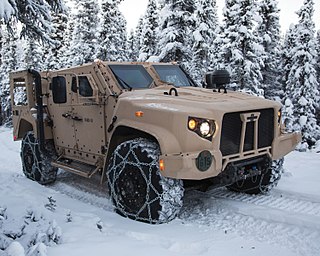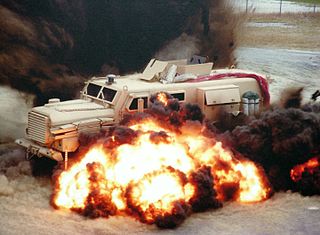
The High Mobility Multipurpose Wheeled Vehicle is a family of light, four-wheel drive, military trucks and utility vehicles produced by AM General. It has largely supplanted the roles previously performed by the original jeep, and others such as the Vietnam War-era M151 jeep, the M561 "Gama Goat", their M718A1 and M792 ambulance versions, the Commercial Utility Cargo Vehicle, and other light trucks. Primarily used by the United States military, it is also used by numerous other countries and organizations and even in civilian adaptations. The Humvee saw widespread use in the Gulf War of 1991, where it navigated the treacherous desert terrain; this usage helped to inspire civilian Hummer versions. The vehicle's original unarmored design was later seen to be inadequate, and was found to be particularly vulnerable to improvised explosive devices in the Iraq War. The U.S. hastily up-armored select models and replaced front-line units with the MRAP. The U.S. military sought to replace the vehicle in front-line service under the Joint Light Tactical Vehicle (JLTV) program. In 2015 the Oshkosh L-ATV was selected for production.

The Mowag Eagle is a series of wheeled armoured vehicle designed by Mowag a Swiss company now owned by GDELS.

The Buffalo is a wheeled mine resistant ambush protected (MRAP) armored military vehicle built by Force Protection, Inc., a division of General Dynamics. It is the largest vehicle in Force Protection's line-up, followed by the Cougar MRAP and the Ocelot light protected patrol vehicle (LPPV).

The Cougar is a mine-resistant ambush-protected (MRAP) and infantry mobility vehicle structured to be resistant to landmines and improvised munitions.
Force Protection, Inc. was a manufacturer of ballistic- and blast-protected vehicles from the United States which have been used in Iraq, Afghanistan, Kosovo and other hot spots around the world. The company was acquired by General Dynamics in 2011.

The Snatch Land Rover is a protected patrol vehicle based on the Land Rover Defender 110 chassis. Intended for general patrolling in low-threat areas, the vehicle was developed in 1992 for use in Northern Ireland. It provides a limited degree of small arms protection for occupants and a limited level of protection from Improvised Explosive Devices and off-route mines.

The Cheetah MMPV was a prototype built by the Force Protection, Inc., division of General Dynamics. It was intended as part of Force Protection's armoured military vehicle line-up, which includes the MRAP-class of Buffalo and Cougar vehicles and the Ocelot light protected patrol vehicle (LPPV).

An infantry mobility vehicle (IMV) is a wheeled armored personnel carrier (APC) serving as a military patrol, reconnaissance or security vehicle. Examples include the ATF Dingo, Iveco LMV, Oshkosh M-ATV, AMZ Dzik, AMZ Tur, Mungo ESK, and Bushmaster IMV. This term also applies to those vehicles fielded as part of the MRAP program.

The Joint Light Tactical Vehicle (JLTV) is a U.S. Army, U.S. Marine Corps and Special Operations Command program to partially replace the Humvee fleet with a family of more survivable vehicles having a greater payload. Early studies for the JLTV program were approved in 2006. The JLTV program incorporates lessons learned from the earlier Future Tactical Truck Systems program and other associated efforts.

Mine-Resistant Ambush Protected is a term for United States military light tactical vehicles produced as part of the MRAP program that are designed specifically to withstand improvised explosive device (IED) attacks and ambushes. The United States Department of Defense MRAP program began in 2007 as a response to the increased threat of IEDs during the Iraq War. From 2007 until 2012, the MRAP program deployed more than 12,000 vehicles in the Iraq War and War in Afghanistan.

The International MXT-MV is an infantry mobility vehicle produced by Navistar Defense, a subsidiary of Navistar International, which is the owner of the International brand of vehicles. Introduced in 2006 and developed in parallel with the civilian International MXT, the MXT-MV is extensively modified for military duty compared to its civilian counterpart. It is transportable by the Lockheed C-130 Hercules military aircraft.
The Humvee replacement process was an effort by the U.S. military to replace the current AM General Humvee multi-purpose motor vehicle. The Humvee had evolved several times since its introduction in 1984, and is now used in tactical roles for which it was not originally intended. The U.S. military pursued several initiatives to replace it, both in the short and long term. The short-term replacement efforts utilize commercial off-the-shelf (COTS) vehicles, while the long-term efforts focused on building requirements for the Humvee replacement and technology research and evaluation in the form of various prototype vehicles.
Force Protection Europe (FPE) was the European subsidiary of Force Protection Inc, which was acquired by General Dynamics in 2011. The UK-based company developed the Foxhound, a light-weight mine-protected military vehicle, which was developed to replace the Snatch Land Rover. FPE won a £180 million contract from the British Ministry of Defence in 2010 to supply 200 Foxhound vehicles. Following the acquisition by General Dynamics in December 2011, the Foxhound is marketed as part of General Dynamics Land Systems vehicle portfolio.
The Mahindra Mine Protected Vehicle-I (MPV-I), is an Indian MRAP-type armored personnel carrier manufactured by Defense Land Systems, a joint-venture of Mahindra & Mahindra Limited and BAE Systems, the first vehicle made under the venture. It is an improved Casspir variant built under licence.

The Hawkei is an Australian light four-wheel-drive protected mobility vehicle. Originally designed in 2010 to meet an Australian Defence Force (ADF) requirement for a light armoured patrol vehicle to replace some of its Land Rover Perentie variants. The Hawkei is a highly mobile, highly protected, 7-tonne vehicle, with inbuilt systems to allow it to be used as a fighting platform. It has been developed with Vehicle Electronic Architecture to be mission system ready. It is intended to undertake a range of mission profiles, including troop movement, command and control, electronic warfare, liaison, surveillance and reconnaissance. Prime contractors include: Thales Australia, Boeing Australia, Plasan (Israel) and PAC Group. In October 2015, the Australian Government announced the purchase of 1,100 Hawkei vehicles from Thales Australia.
Burraq is a Mine-Resistant Ambush Protected (MRAP) Vehicle currently being developed by Heavy Industries Taxila (HIT) of Pakistan. It is a 4x4 Protected vehicle based on the chassis of the Isuzu NPS-75 commercial truck so as to reduce the cost and facilitate the delivery of spare parts. In appearance, the Burraq is quite similar to the Wildcat MRAP, developed by the Israel Military Industries (IMI).

The Oshkosh L-ATV is a light utility/combat multi-role vehicle that won the US military's Army-led Joint Light Tactical Vehicle (JLTV) program. In the very early stages of the program it was suggested that JLTV would replace the AM General High Mobility Multi-purpose Wheeled Vehicle (HMMWV) on a one-for-one basis. It is now suggested that the JLTV will partly replace the HMMWV, not replace it on a like-for-like basis.

Typhoon is a Russian family of Mine-Resistant Ambush Protected (MRAP) armored fighting vehicles (AFVs) in service since 2014. Around 120 Russian companies including KamAZ, Gaz-Group, and Bauman University, etc. are taking part in Typhoon program. The main aim of the program is to design a unified platform for all Russian armored wheeled vehicles.
The Multi Role Vehicle-Protected (MRV-P) is a programme to deliver future wheeled utility and logistics vehicles for the British Army.
General Dynamics UK is a British subsidiary of the American defence and security corporation General Dynamics. Founded in London in 1962, the company has grown to include eight sites across the United Kingdom, including in Bristol, Chippenham, Hastings, Merthyr Tydfil, Oakdale and Rotherham. Specialising in armoured fighting vehicles, avionic systems and tactical communications, the company has produced the General Dynamics Ajax armoured fighting vehicle, the Ocelot light protected patrol vehicle and the Bowman communications system. It is one of the UK's leading defence companies and a key supplier to the UK Ministry of Defence.















